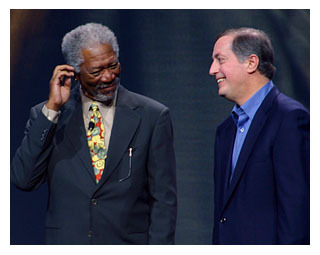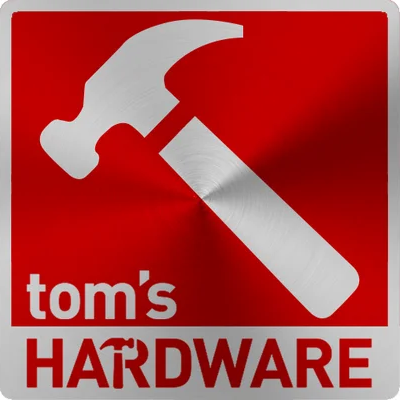CES 2006 Analysis: Core processor is Intel's ticket to Hollywood
For most of last year, Intel has been feeding journalists and consumers with bite-sized portions of information about its first dual-core mobile processor. More performance, less power consumption, reduced heat - these were the promises that set consumers' expectations for these chips at a very high level. Thursday night, Intel president and CEO Paul Otellini did his best to deliver on these expectations with some hard data, and with a crisper, sharper outline of Core's purpose: not only to step up performance in mobile computers, but ultimately to be consumers' key to Hollywood's wealth of digital content.
At its heart, Core is a faster processor, of course, than the current Pentium M with its Dothan core. Powered by two cores and utilizing 65 nm lithography in its production process, Core is Intel's first completely new "premium" product since the introduction of the original Pentium processor eleven years ago. Compared to Pentium, "Core Duo" has about one-third its die size, and is about 100 times faster, Otellini said. And while the current Pentium M continues to sell well - Otellini mentioned more than 30 million Pentium M notebooks shipped in the past 12 months - Core will launch in twice as many notebook models as Pentium M, resulting in projected shipments of more than one million Core chips within the first three weeks after launch, Otellini said.
These sales will not only come from notebooks, Intel believes, but also from its strategy to place Core Duo at the heart of its entertainment-focused Viiv platform. 110 different Viiv models are available now, or will become available within a few weeks, hopefully resulting in significant sales. As the engine of Viiv, Core has the unenviable task of upgrading the firm's image from a cold, geeky tech company, into a sparkling CE brand. To accomplish this, Viiv's guiding principle is to provide consumers with easy-to-use CE functionality, more processor speed, and expedited access to digital content.
Users of Viiv components will be bombarded with the "Enjoy with Viiv" tagline, on the surfaces of both PC cases and software user interfaces. While Intel hopes this marketing phrase catches on with consumers the way Coca-Cola catch-phrases have caught on in the past, Viiv simultaneously maintains a separate message intended to appease content owners, who require assurance that their own core products are being safeguarded. Perhaps to keep the consumer message toned down, unfortunately, Intel did not release details about Viiv's digital rights management (DRM) features Thursday. But Intel did succeed in convincing Sony - the present-day poster child for piracy paranoia - to join the Viiv parade. So at least one message already appears to be working.
Performance, security, and a huge marketing investment, have all enabled Intel to attract more digital content than any other CE marketing campaign heretofore. For example, the company announced its partnership with DirecTV for a Viiv-branded satellite receiver, and persuaded NBC Universal to create Viiv content around its network's coverage of the upcoming Winter Olympics. AOL will offer free Radio and Movie channels - yes, we said "free," a term that is very rare at this year's CES. In fact, AOL has also announced advertising-supported streaming of video and music content for Viiv PCs. Don't expect blockbuster titles or "Desperate Housewives" to be available just yet, but "Babylon 5" may suffice for now.
Here is where Intel's ClickStar - a movie distribution firm that the company co-founded with actor Morgan Freeman - comes into play: ClickStar will be among the first producers to debut movies for Viiv. The Oscar-winning actor joined Otellini during his CES keynote speech on stage to announce ClickStar's upcoming movie premiere, later joined under Intel's spotlight by actors Tom Hanks and Danny DeVito. Phrases such as "democratizing movies," "putting actors and consumers in control," and the perennial favorite, "creating choice," filled these actors' prepared statements. For the very first time, and for a brief few moments, they managed to provide the normally staid Intel brand with a soft touch of Hollywood excitement.
Meanwhile, the raw information streaming - albeit in moderate to low bandwidth - from Otellini's keynote, as well as from Intel's 12,000 square foot CES booth, does not yet provide enough clues as to whether Viiv has the potential to be successful, or whether subscription-based content can get customers excited enough to shell out at least $900 for a Viiv PC. In the end, Viiv's content will be protected content, and we would disagree with Otellini's claim that Viiv will "put the user in control" of what content he consumes, when, and how. Ultimately, it will be content providers - many of whom still go by the old-fashioned moniker, "studios" - that will retain a tight leash on Viiv content, and that will control how we will be able to consume it.
Get Tom's Hardware's best news and in-depth reviews, straight to your inbox.
Otellini did confirm, though, that his company has identified CE as growth opportunity, and will go after that market using whatever it takes. We have no doubt that Intel will aggressively tackle every obstacle along the way. But there may be still some substantial hurdles to overcome before Otellini's predicted "revolution" takes place.
For example: Even as we are told that devices such as Viiv will revolutionize our content consumption habits, there is surprisingly little discussion about what consumers actually want. We heard that Viiv puts users in charge, and we heard that Intel believes that users are demanding that premium content be squeezed through broadband lines. However, details about planned DRM features - a key factor in consumers' final determination of the value of digital content - are scarce, if not non-existent, both from Intel and its entertainment industry partners. [When Freeman's joint venture with Intel debuted last September, officials from his company with whom we met in person, referred us to a videotaped message, where Freeman advised his viewers to rest assured: Content cannot be copied. No further questions.] Continuing to downplay the importance of DRM by escaping into generalized explanations, may not be adequate for consumers in the near future, if not so already. Instead, Intel may become pressured to provide consumers with more facts regarding how and why digital content is locked down.
Seeing Otellini spotlighted on the big stage, surrounded by popular Hollywood figures, was a surreal spectacle unto itself. At times, it became a strange coordination of false impromptu conversation using prepared sentences read from TelePrompTers. At one point, in the middle of the production, while standing on stage, DeVito accepted a phone call he said was coming from his wife, comedienne Rhea Perlman. While spectators wondered what newfangled communications device this conversation would unveil, Freeman and Otellini were left to ad lib their portions of the script, which included reading over DeVito's TelePrompTer lines. The call concluded with nothing emerging from it - no new announcement, no prepared sketch, just an unrehearsed break in the action.
The whole scene served to symbolize the huge gap between Intel and the CE industry, in how the two parties view the business of providing digital content - the conceptual chasm between the business lecture and the theatrical production. Earlier Thursday, in his own CES keynote address, Sony CEO and chairman Sir Howard Stringer mentioned that his firm is trying to tie the knot with the user. But along the way to accomplishing this marriage, he said, his company faced certain obstacles of misunderstandings.
Sir Howard's declaration may be even more applicable to the emerging, if fledgling, relationship between IT giants such as Intel and the CE industry, spurious interruptions from spouses notwithstanding. Only if Intel learns how to bridge the gaps that apparently still exist in the two industries' divergent philosophies of creating, marketing, and selling information as entertainment, then the company's Core ticket, and its efforts to become a major voice in Hollywood, may yet pay off.
Tom's Hardware is the leading destination for hardcore computer enthusiasts. We cover everything from processors to 3D printers, single-board computers, SSDs and high-end gaming rigs, empowering readers to make the most of the tech they love, keep up on the latest developments and buy the right gear. Our staff has more than 100 years of combined experience covering news, solving tech problems and reviewing components and systems.


